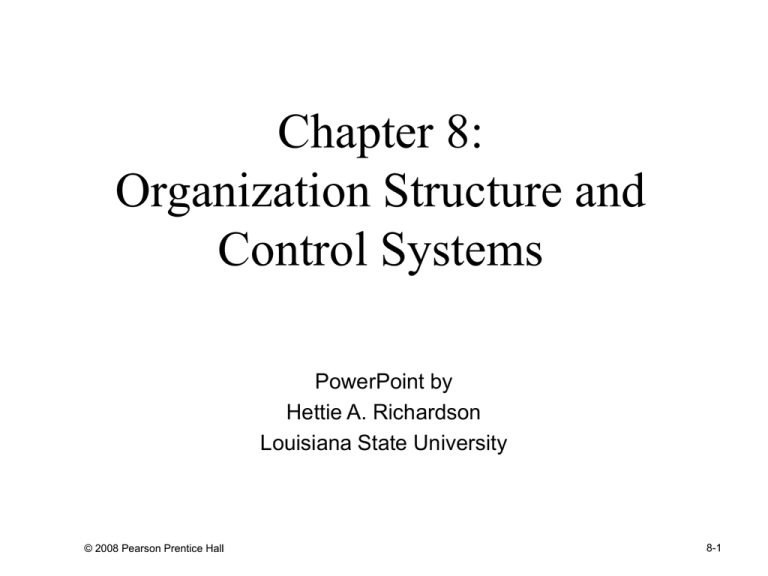
Chapter 8:
Organization Structure and
Control Systems
PowerPoint by
Hettie A. Richardson
Louisiana State University
© 2008 Pearson Prentice Hall
8-1
Opening Profile: Changing
Structures in Emerging Markets
Expansion modes in emerging
markets may not fit the mainstream
MNC model
Many are “born global”
Competition is limited in niche
businesses
They thrive in old-economy industries
abandoned by established MNCs
© 2008 Pearson Prentice Hall
8-2
Opening Profile: Changing
Structures in Emerging Markets
Family based governance structures and rigid
control systems must be redefined
Hybrid structures and fast-growth entities will
emerge
© 2008 Pearson Prentice Hall
8-3
Organizational Structure
Must evolve to accommodate
internationalization
Must “fit” with strategy
Should be contingency based
© 2008 Pearson Prentice Hall
8-4
Evolution and Change in
Structures
Stages model
Alcoa
Created smaller units
Linked geographically dispersed, but
similar businesses (e.g., Brazil and
Australia)
© 2008 Pearson Prentice Hall
8-5
International Division
Organized along functional, product, or
geographic lines
IBM World Trade
Pepsi Cola International
© 2008 Pearson Prentice Hall
8-6
Global Functional Structure
Designed on the basis of the company’s
functions
Allows for functional specialization and
economies of scale
© 2008 Pearson Prentice Hall
8-7
Organizing for Globalization
Need for differentiation
Need for globalization
IBM
Rationalization
Development of alliances
© 2008 Pearson Prentice Hall
8-8
Comparative Management in Focus:
The Overseas Chinese Global Network
“Chinese commonwealth”
Overseas Chinese
Control $2 trillion in liquid assets
Contribute 80% of the capital for the PRC
Contribute 70% of the private sector in
Malaysia, Thailand, Indonesia, and the
Philippines
© 2008 Pearson Prentice Hall
8-9
Comparative Management in Focus:
The Overseas Chinese Global Network
The Overseas Chinese business culture
Business largely confined to family and
trusted friends—guanxi
Adherence to patriarchal authority
Thrift and a high savings level
Investment in tangible goods
Wary outlook
© 2008 Pearson Prentice Hall
8-10
Organizing to “Be Global, Act
Local”
Colgate-Palmolive
Primary structure is geographic
CEO oversees centralized operations
Levi Strauss
Allows managers to act independently
Keeps some centralized control, but
decentralizes control of foreign subsidiaries
© 2008 Pearson Prentice Hall
8-11
Management Focus: Proctor and
Gamble’s Structure
P&G/Gillette merger: Gillette adopts P&G’s
organizational structure
P&G’s structure:
Global Business Unit (GBU)
Market Development Organization (MDO)
Global Business Services (GBS)
© 2008 Pearson Prentice Hall
8-12
Emergent Structural Forms
Interorganizational networks
Royal Philips Electronics
Intel
Global e-corporation network structure
© 2008 Pearson Prentice Hall
8-13
Emergent Structural Forms
Transnational corporation (TNC) network
structure
Asea Brown Boveri (ABB)
© 2008 Pearson Prentice Hall
8-14
When is Change Needed?
Clashes among divisions, subsidiaries, or
individuals over territories or customers
Duplication of administrative or personnel
services, sales offices, account executives
An increase in overseas customer service
complaints
© 2008 Pearson Prentice Hall
8-15
When is Change Needed?
A shift in operational scope
Conflict between overseas and domestic staff
Centralization leads to excessive and, thus,
misused or misunderstood data
Unclear reporting relationships
© 2008 Pearson Prentice Hall
8-16
Direct Coordinating
Mechanisms
McDonald’s in Moscow
Problem: Quality control
Solution: Built processing plant in Moscow
and provided managerial training
Other options: Visits by head-office
personnel and regular meetings
© 2008 Pearson Prentice Hall
8-17
Indirect Coordinating Mechanisms
Examples: sales quotas, budgets, and
financial tools and reports
Three financial statements
One for accounting standards in host
country
One for the standards in the home country
One for consolidation
© 2008 Pearson Prentice Hall
8-18
The Appropriateness of Systems
Where are top managers from?
US individualism vs. Japanese collectivism
© 2008 Pearson Prentice Hall
8-19
The Role of Information Systems
US MNCs monitor via specific functional
reports
Inaccurate information, different norms, MIS
adequacy
Noncomparability of performance data
© 2008 Pearson Prentice Hall
8-20
Evaluation Variables across
Countries
Adjust statements to reflect variables unique
to each country
Take nonfinancial measures into account
© 2008 Pearson Prentice Hall
8-21







